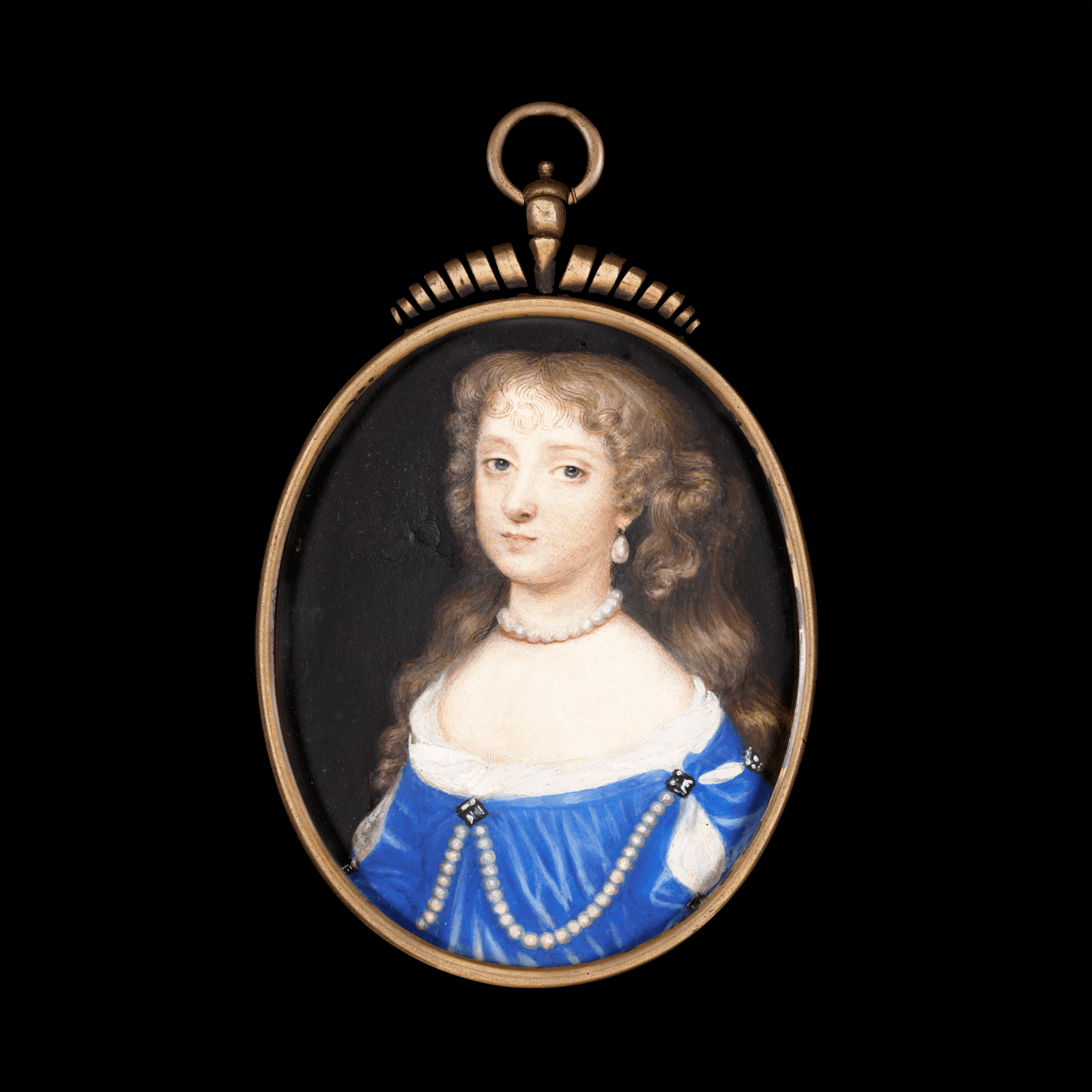
Richard Gibson
A Lady, wearing blue dress over white chemise, with looped pearls and diamonds, her blonde hair curled and worn loose, c. 1665
Watercolour on vellum
Oval, 2 ½ in. (64 mm) high
Philip Mould & Co.
To view all current artworks for sale visit philipmould.com Little is known about the early years of Richard Gibson’s life – he may have hailed from Cumberland, but equally he...
To view all current artworks for sale visit philipmould.com
Little is known about the early years of Richard Gibson’s life – he may have hailed from Cumberland, but equally he may have been the son of a ‘picturemaker’ in London. He called himself (and signed his miniatures) ‘Dwarf Gibson’. He must have shown some artistic aptitude from an early age, as, after working as page for a lady in Mortlake he was then apprenticed to Francis Cleyn, the head of the new tapestry works in the same parish.
Gibson’s artistic career continued apace within the household of the art-loving connoisseur, Philip Herbert 4th Earl of Pembroke, where he may have first met the artist Peter Lely. By 1639 he was at court, employed as a ‘Page of the Back-Stairs’, experiencing great popularity with Charles I. Through the catalogue of Abraham van der Doort, Keeper for the royal collection, we know that by this point Gibson was actively painting, for the former recounts the artist copying ‘the Picture of Adonis Venus Cupid and some doggs by Peter Oliver after Titian’. Following Pembroke’s death, Gibson attached himself to Charles, 2nd Earl of Carnarvon, Pembroke’s grandson, and throughout the Interregnum painted many people of that circle including Lady Elizabeth Dormer [V&A] and Elizabeth, Countess of Carnarvon [Scottish National Portrait Gallery; exhibited at Philip Mould & Co ‘Warts and All’ 2013 no.37].
The present work is datable to circa 1665, when Gibson was established as a professional artist, while still retaining his links to the Carnarvon circle. Likely presenting this young woman as a future bride, Gibson has carefully painted the numerous large pearls worn as jewellery and pinned to the dress She bears a close resemblance to Lucy Loftus (née Brydges), who married Adam Loftus, afterwards Viscount Lisburne. She was the daughter of 6th Baron Chandos of Sudeley and was painted circa 1667 by Peter Lely, the favourite court painter in oil.[1] Here Gibson has recreated in little the sensuous brushwork of Lely’s oil portraits, with the sitter’s head tilted slightly back.
Gibson was tremendously successful as a miniaturist and by the late 1660’s he changed his signature from ‘DG’, for ‘Dwarf’ or maybe ‘Dick’ to ‘RG’ for Richard, a pertinent display of his new status. After Cooper’s death Gibson was pronounced the King’s Limner, however one year later he was succeeded by Nicholas Dixon. His final position was more one of art dealer, teacher (to Princesses Mary and Anne) and diplomat. He accompanied Mary to Holland to marry William of Orange in 1677, returning with her to be crowned alongside her husband in 1688.
[1] Birmingham Museum’s Trust, accession number1941P338.
Little is known about the early years of Richard Gibson’s life – he may have hailed from Cumberland, but equally he may have been the son of a ‘picturemaker’ in London. He called himself (and signed his miniatures) ‘Dwarf Gibson’. He must have shown some artistic aptitude from an early age, as, after working as page for a lady in Mortlake he was then apprenticed to Francis Cleyn, the head of the new tapestry works in the same parish.
Gibson’s artistic career continued apace within the household of the art-loving connoisseur, Philip Herbert 4th Earl of Pembroke, where he may have first met the artist Peter Lely. By 1639 he was at court, employed as a ‘Page of the Back-Stairs’, experiencing great popularity with Charles I. Through the catalogue of Abraham van der Doort, Keeper for the royal collection, we know that by this point Gibson was actively painting, for the former recounts the artist copying ‘the Picture of Adonis Venus Cupid and some doggs by Peter Oliver after Titian’. Following Pembroke’s death, Gibson attached himself to Charles, 2nd Earl of Carnarvon, Pembroke’s grandson, and throughout the Interregnum painted many people of that circle including Lady Elizabeth Dormer [V&A] and Elizabeth, Countess of Carnarvon [Scottish National Portrait Gallery; exhibited at Philip Mould & Co ‘Warts and All’ 2013 no.37].
The present work is datable to circa 1665, when Gibson was established as a professional artist, while still retaining his links to the Carnarvon circle. Likely presenting this young woman as a future bride, Gibson has carefully painted the numerous large pearls worn as jewellery and pinned to the dress She bears a close resemblance to Lucy Loftus (née Brydges), who married Adam Loftus, afterwards Viscount Lisburne. She was the daughter of 6th Baron Chandos of Sudeley and was painted circa 1667 by Peter Lely, the favourite court painter in oil.[1] Here Gibson has recreated in little the sensuous brushwork of Lely’s oil portraits, with the sitter’s head tilted slightly back.
Gibson was tremendously successful as a miniaturist and by the late 1660’s he changed his signature from ‘DG’, for ‘Dwarf’ or maybe ‘Dick’ to ‘RG’ for Richard, a pertinent display of his new status. After Cooper’s death Gibson was pronounced the King’s Limner, however one year later he was succeeded by Nicholas Dixon. His final position was more one of art dealer, teacher (to Princesses Mary and Anne) and diplomat. He accompanied Mary to Holland to marry William of Orange in 1677, returning with her to be crowned alongside her husband in 1688.
[1] Birmingham Museum’s Trust, accession number1941P338.